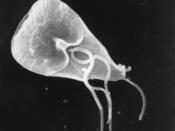Ortiz � PAGE �4�
Pattie Ortiz
Voigt
Anatomy & physiology/ Period 5
21 March 2010
Giardia lamblia exists in two forms, an active form called a trophozoite, and an inactive form called a cyst. The active trophozoite attaches to the lining of the small intestine with a "sucker" and is responsible for causing the signs and symptoms of giardiasis. The trophozoite cannot live long outside of the body; therefore it cannot spread the infection to others. The inactive cyst, on the other hand, can exist for prolonged periods outside the body. When it is ingested, stomach acid activates the cyst, and the cyst develops into the disease-causing trophozoite. It takes ingestion of only ten cysts to cause infection. Trophozoites are important not only because they cause disease, they also produce cysts that exit the body in feces and spread infection to others.[1]
The Giardia parasite lives throughout the world in all climates and conditions.
The feces of animals and humans infected with giarda contain millions of guardian parasites. When an infected animal defecates, its giardia organisms are released into the environment and wait for additional unsuspecting hosts. This means water, soil, food, or anything that the feces of people or animals infected with guardian may have come in contact with can infect anyone. It is important that hands are washed frequently, especially after each bowel movement. For wilderness survivors, the most common means of contracting guardian is by drinking contaminated water. Animals such as beavers, muskrats, moose, deer and many others commonly defecate in or near water. This serves to spread the guardian parasite to other animals throughout the area. Unfortunately, people are also to blame for the spread of Giardia. Many outdoors enthusiasts do not understand even the basics of proper human waste disposal and will often relieve...


